What got all of this started was a thread I started here on ECF (after being goaded by a certain Admin paybacks are hell). I had discovered some new research by Wang and Guiss suggesting that carcinogens (like formaldehyde) start getting produced at high temperatures, temperatures that were within the normal range of vaping, ie before encountering a dry hit. So I posted the research.
I fully expected numbers from a real modern day atty would be lower than Wang's, as 100% of the juice in Wangs study was exposed to the specified temperature. Whereas in a real atty a significant portion of the juice does not contact the coil, but vaporizes at a lower temp directly off the wick. My gut told me the thermal degradation phenomena is genuine, but I had no clue what magnitude we would see in a real atty.
I got flamed to hell and back for posting that thread. A lot half baked malarkey, with little to no base in fact, got thrown at me in opposition. Also, since thermal degradation is triggered by temp, many of the VW mod users had legitimate concerns about what temps they might be vaping at. So I started doing professional temperature testing on real attys and posting the results in my blog. That led to "why not test for formaldehyde too". One of the members shared a video showing a relatively inexpensive formaldehyde meter and suggested we get one. Several of the members then generously contributed towards buying one of these meters.
What resulted is the first publicly posted (to my knowledge) results of thermal degradation formaldehyde testing on a real atty, and under real vaping conditions. I.e. how much formaldehyde is generated at what temperature.
Test Gear Utilized:
My Testing Setup:
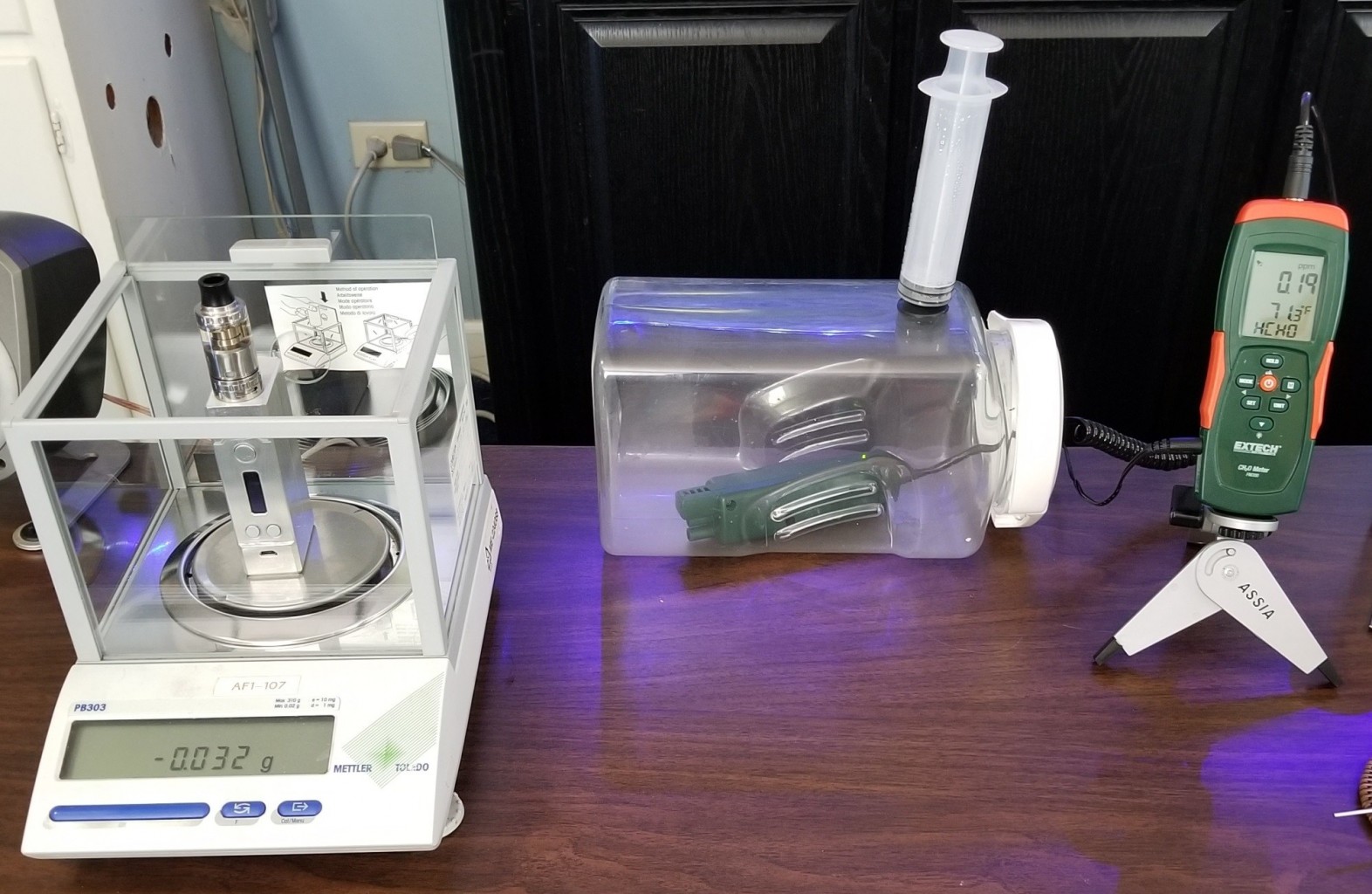
So, here are my bottom line results, they were not nearly as severe as some of the unrealistic studies floating around.
Test Considerations:
Test Data:
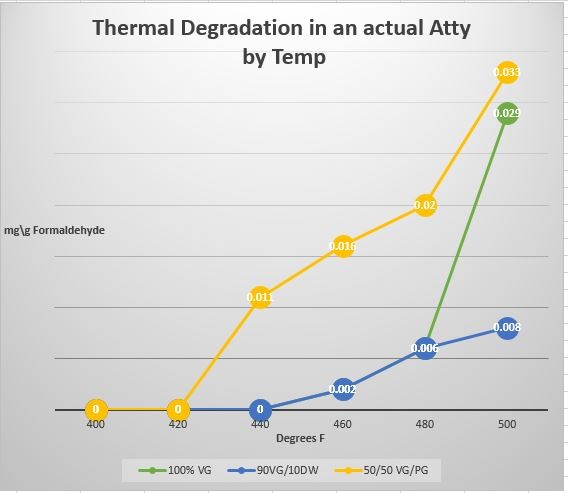
The above results are inline with Dr Kurts study, however it is difficult to know what temperature he was running at various wattage settings. I would propose that his higher mg\g values were also higher temperatures.

My Testing:
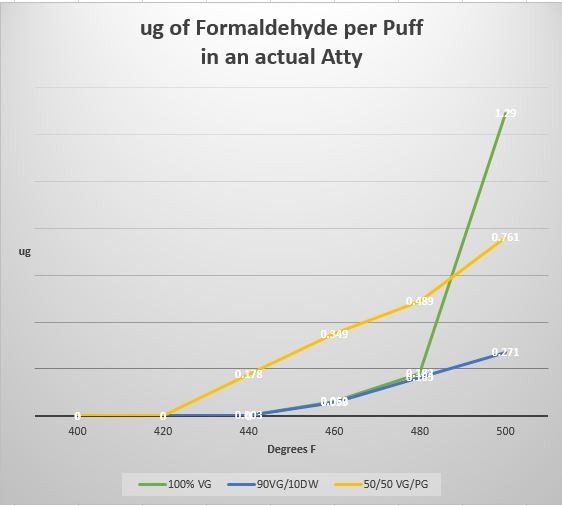
Now multiply these values by how many puffs you take a day.
Again, the above results are inline with Dr Kurts study, however it is difficult to know what temperature he was running at various wattage settings. I would propose that his higher ug\puff values were also higher temperatures.

Lets keep the "per puff" in perspective, here is "per puff" for tobacco:
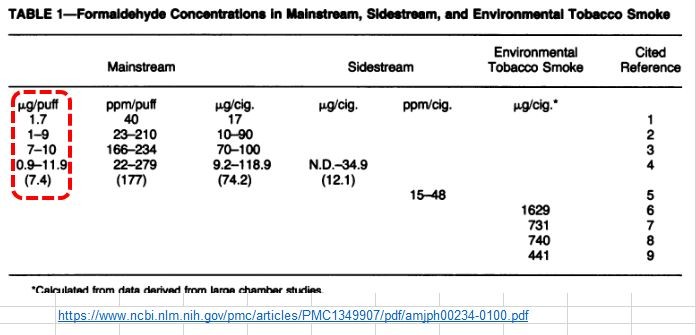
From our own Dr Kurt:

Thermal Degradation is real folks.
Temperature Matters.....................
The ACTUAL statement made by the Royal College of Physicians, 11 St Andrews Place, Regent's Park, London NW1 4LE
"E-cigarettes and long-term harm - the possibility of some harm from long-term e-cigarette use cannot be dismissed due to inhalation of the ingredients other than nicotine, but is likely to be very small, and substantially smaller than that arising from tobacco smoking. With appropriate product standards to minimise exposure to the other ingredients, it should be possible to reduce risks of physical health still further. Although it is not possible to estimate the long-term health risks associated with e-cigarettes precisely, the available data suggest that they are unlikely to exceed 5% of those associated with smoked tobacco products, and may well be substantially lower than this figure."
Please note the part highlighted in green. What they are saying is that there is "probably" more we can do to make vaping even safer!
Also note this statement from the University of Cambridge Cancer Institute:
"We also know that different users use different devices and liquids. So it could be that some are safer or more harmful than others. And people also use the devices in different ways. So further work needs to be done to understand these differences, so that each vaper is using their device as safely as possible."
Related Blogs of interest:

Supporting data for those who wish to analyze it:
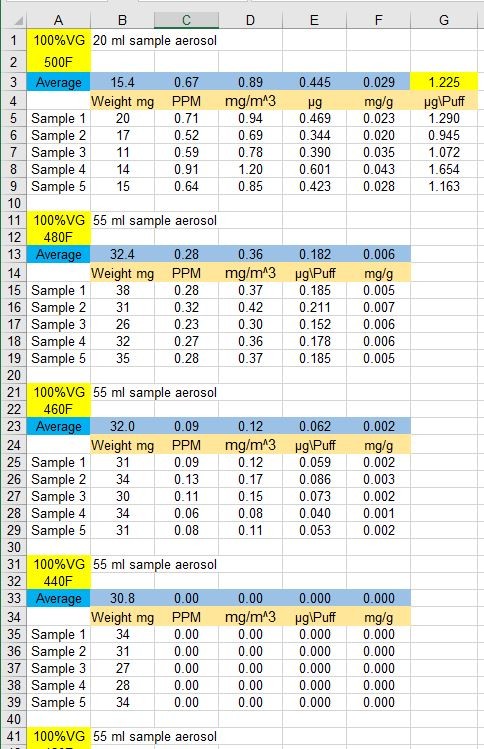
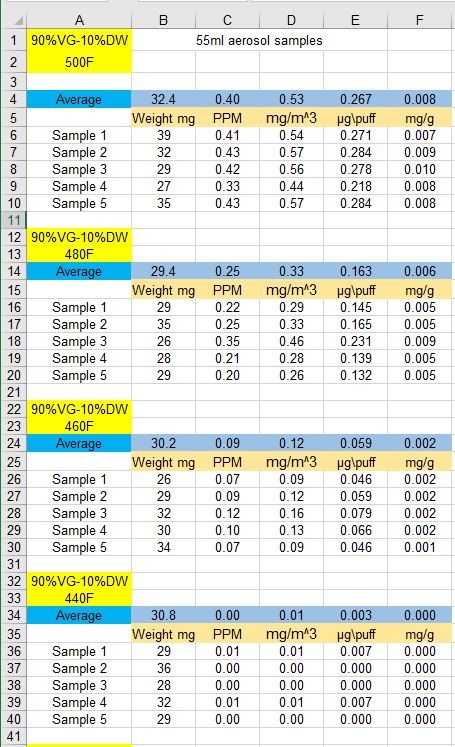
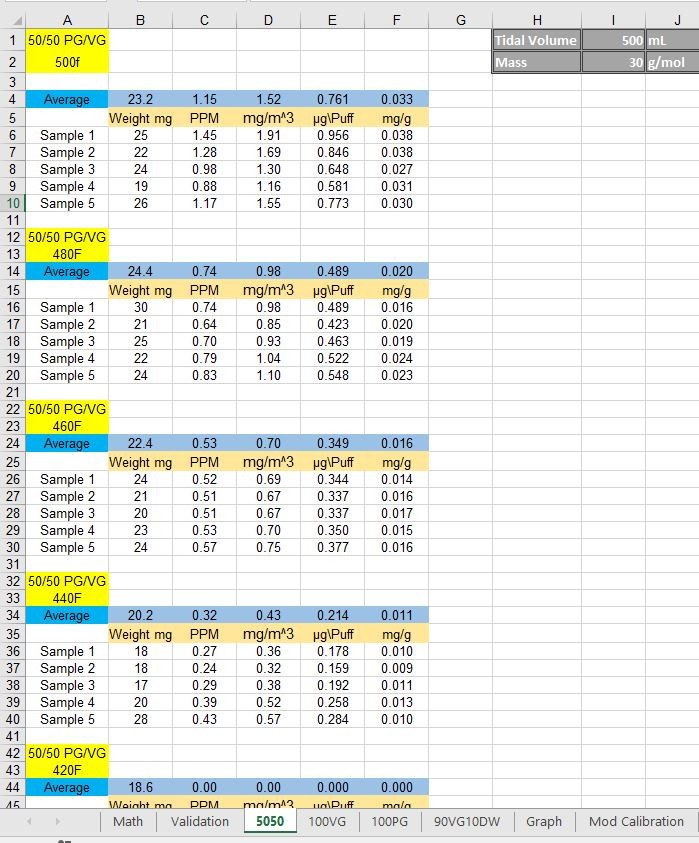

©2017 Mike Petro. This is an open access article distributed under the terms of the Creative Commons Attribution License, which permits unrestricted use, distribution, and reproduction in any medium, provided the original author and source are credited.
I fully expected numbers from a real modern day atty would be lower than Wang's, as 100% of the juice in Wangs study was exposed to the specified temperature. Whereas in a real atty a significant portion of the juice does not contact the coil, but vaporizes at a lower temp directly off the wick. My gut told me the thermal degradation phenomena is genuine, but I had no clue what magnitude we would see in a real atty.
I got flamed to hell and back for posting that thread. A lot half baked malarkey, with little to no base in fact, got thrown at me in opposition. Also, since thermal degradation is triggered by temp, many of the VW mod users had legitimate concerns about what temps they might be vaping at. So I started doing professional temperature testing on real attys and posting the results in my blog. That led to "why not test for formaldehyde too". One of the members shared a video showing a relatively inexpensive formaldehyde meter and suggested we get one. Several of the members then generously contributed towards buying one of these meters.
What resulted is the first publicly posted (to my knowledge) results of thermal degradation formaldehyde testing on a real atty, and under real vaping conditions. I.e. how much formaldehyde is generated at what temperature.
Test Gear Utilized:
- DNA 200, calibrated, and validated, to be +/- 10 degrees in accuracy
- Merlin RTA with a 0.51ohm, 5/6 wrap, 28g TI coil, and a rayon wick.
- Mettler Toledo PB303, freshly calibrated.
- Extech FM200 Formaldehyde Meter with a fresh factory calibration
- The testing was performed under actual vaping conditions.
- Juices were 36mg (its what I vape) and were unflavored as I didnt want flavorings to skew the results. Flavorings are a whole different can of worms and really need to be tested in and of themselves.
- VG and PG were from Essential Depot, nic was from E-Liq.com
My Testing Setup:

- I am using a 500ml chamber to store the probe and inject the sample into. Also know as "tidal volume". The probe is temp and humidity compensated, so it needed to be in the same conditions as the aerosol being measured.
- I weigh the mod, and tare (zero) the scale.
- I then us a 60ml syringe to draw a 55ml sample (an industry standard puff) directly off the mod while firing. The drip tip was drilled out to snugly fit the syringe tip. The samples were drawn at 3-4 second rate, at a velocity and vacuum equal to a MTL hit.
- I inject the 55ml into the 500ml chamber and allow the reading on the HCH0 meter to stabilize, this can take 10-20 minutes. I then record that PPB reading.
- In the meantime I weigh the mod again and record the mg of juice consumed, which shows as a negative number.
- I did 5 samples of each juice, at each temp, to enhance statistical accuracy.
- The math in my SS then calculates mg/m^3 (converts PPB to mass by volume), µg\Puff, mg/g of formaldehyde per gram of ejuice consumed . My math was validated by a respected PHD.
So, here are my bottom line results, they were not nearly as severe as some of the unrealistic studies floating around.
- Below 440f vaping is relatively formaldehyde free (flavorings not included)
- Above 480f is appears that the 90\10 VG\DW was the safest, which makes perfect sense if you look at the boiling point which is 281f. Even 5% DW would lower the boiling point to 332f and be way below the danger zone.
Test Considerations:
- Tests were performed on accurate TC gear, these results wont directly apply to VV or VW gear because these tests were all "temperature based". It all still comes down to temperature. The amount of formaldehyde generated is a direct result of thermal degradation, the hotter you cook your juice the more formaldehyde you will get. However, the hottest of these tests were done at 500f, if you get much hotter than that you will start to taste "burnt" even if not yet in a dry hit situation. IMHO, if you arent tasting "burnt" (unless strong flavorings cover it up) then you are likely not exceeding the level of a cigarette.
- These test were done on modern gear. Older VV/VW gear might have more severe results due to juice flow inadequacies, and other unfavorable variables etc. Still, IMHO, if you arent tasting "burnt" then you are likely not exceeding the level of a cigarette.
- Formaldehyde was the only nasty tested here. Ecigs can have a few different nasties, but not nearly as many as the hundreds of nasties found in burnt tobacco that arent in vape.
- These tests were done using MTL conditions. I have no clue how they would correlate to DL hits. My gut tells me DL would be higher levels, especially if cloud chasing, simply because you are inhaling higher volumes (more mg) of juice per hit, so if nasties are present at a given temp you will get more of them.
Test Data:

The above results are inline with Dr Kurts study, however it is difficult to know what temperature he was running at various wattage settings. I would propose that his higher mg\g values were also higher temperatures.
My Testing:

Now multiply these values by how many puffs you take a day.
Again, the above results are inline with Dr Kurts study, however it is difficult to know what temperature he was running at various wattage settings. I would propose that his higher ug\puff values were also higher temperatures.
Lets keep the "per puff" in perspective, here is "per puff" for tobacco:

From our own Dr Kurt:
Thermal Degradation is real folks.
- Dr Kurt, Wang, and Guiss have all identified it in one way or another. Many were discredited within our community because they didnt use actual vape gear or conditions.
- I have used actual vape gear and conditions, and I also saw and measured the thermal degradation in our own gear, and at temperatures that many do vape at.
- Volts and Watts equate to a gas pedal, but it is the SPEED (Temperature) that will get you a ticket.
- How FAST you go is determined by the gas pedal, but how hard you have to press the pedal differs from vehicle to vehicle.
- So it is with VV\VW mods, the amount of watts to get over 440f will differ from mod to mod based on those 18 variables.
- If formaldehyde levels concern you, TC mods are a much more accurate way to know how hot you are running. Regardless, vaping is still safer than combustible tobacco!
- And contrary to what many say, "I" couldnt taste anything bad until I hit about 505f! Our taste-buds are not as good of an indicator as some may think.
Temperature Matters.....................
- I am not saying that vaping is unsafe, I am saying that vaping too hot is not as safe as it could be, and that is easily fixable.
- Even at high temperatures, I didnt measure anything that exceeded a cigarette. However I was using a moderate build. Extreme builds, contact coils, multiple coils, Clapton\twisted\braided coils, etc, will have higher levels (at a given temp) than I measured.
- An extreme enough build, at high temp, could indeed exceed formaldehyde levels found in combustible tobacco!
The ACTUAL statement made by the Royal College of Physicians, 11 St Andrews Place, Regent's Park, London NW1 4LE
"E-cigarettes and long-term harm - the possibility of some harm from long-term e-cigarette use cannot be dismissed due to inhalation of the ingredients other than nicotine, but is likely to be very small, and substantially smaller than that arising from tobacco smoking. With appropriate product standards to minimise exposure to the other ingredients, it should be possible to reduce risks of physical health still further. Although it is not possible to estimate the long-term health risks associated with e-cigarettes precisely, the available data suggest that they are unlikely to exceed 5% of those associated with smoked tobacco products, and may well be substantially lower than this figure."
Please note the part highlighted in green. What they are saying is that there is "probably" more we can do to make vaping even safer!
Also note this statement from the University of Cambridge Cancer Institute:
"We also know that different users use different devices and liquids. So it could be that some are safer or more harmful than others. And people also use the devices in different ways. So further work needs to be done to understand these differences, so that each vaper is using their device as safely as possible."
Related Blogs of interest:
- Juice Boiling Point and Vaping Temperatures (includes BP Charts)
- VV & VW Mod Temperature Variables.
- "Best Practices" to avoid high temps on VV/VW mods.
- Mike Petro's Blog Index
- Why should you believe a word I have to say?

Supporting data for those who wish to analyze it:




©2017 Mike Petro. This is an open access article distributed under the terms of the Creative Commons Attribution License, which permits unrestricted use, distribution, and reproduction in any medium, provided the original author and source are credited.



